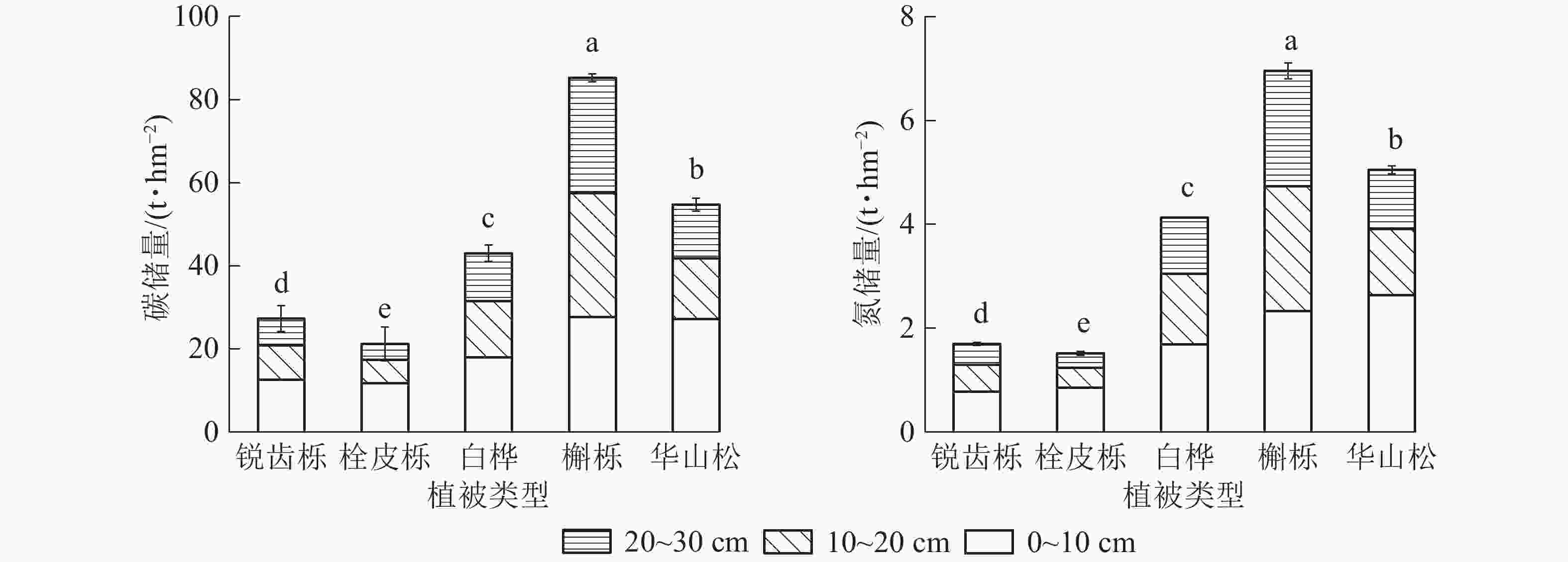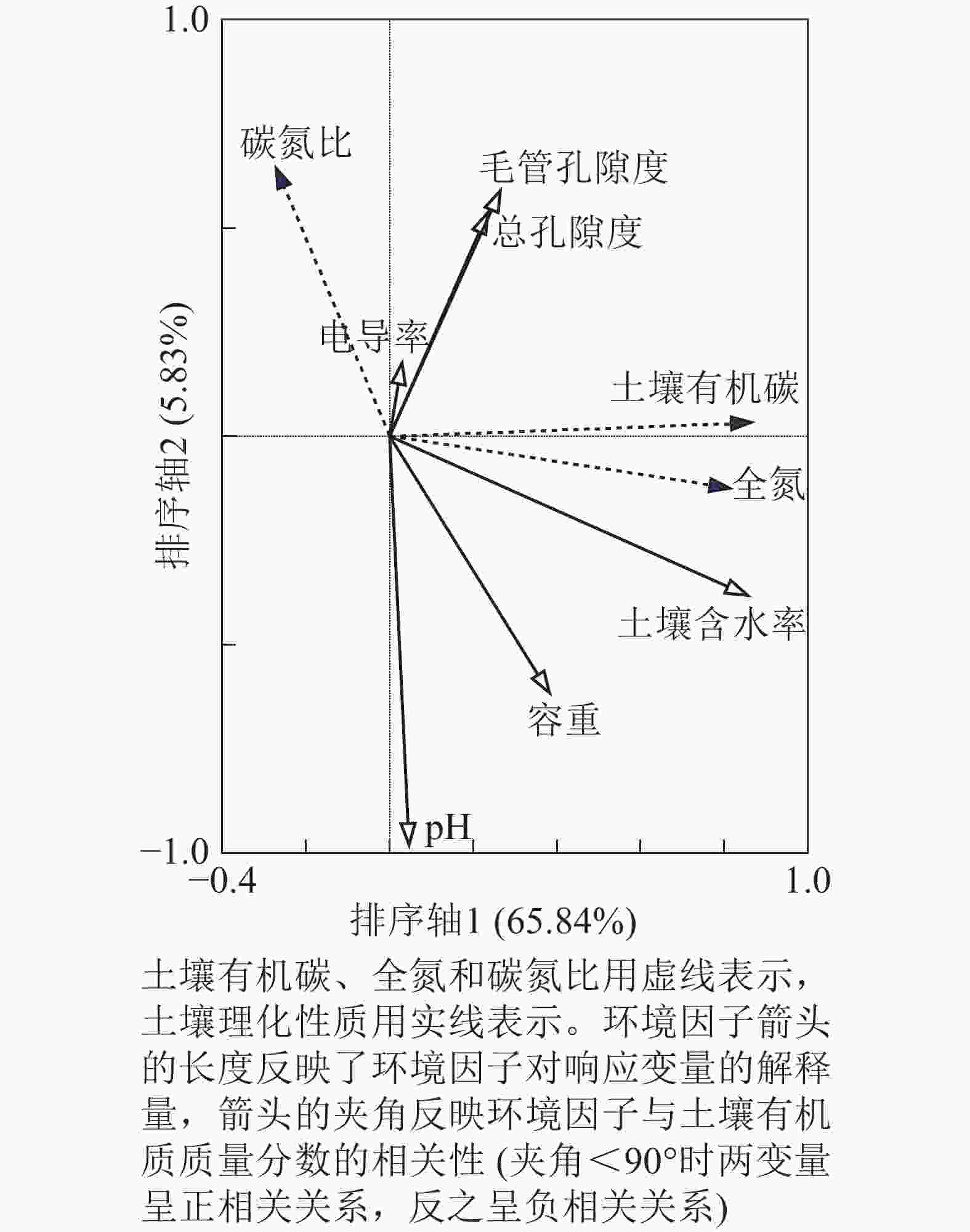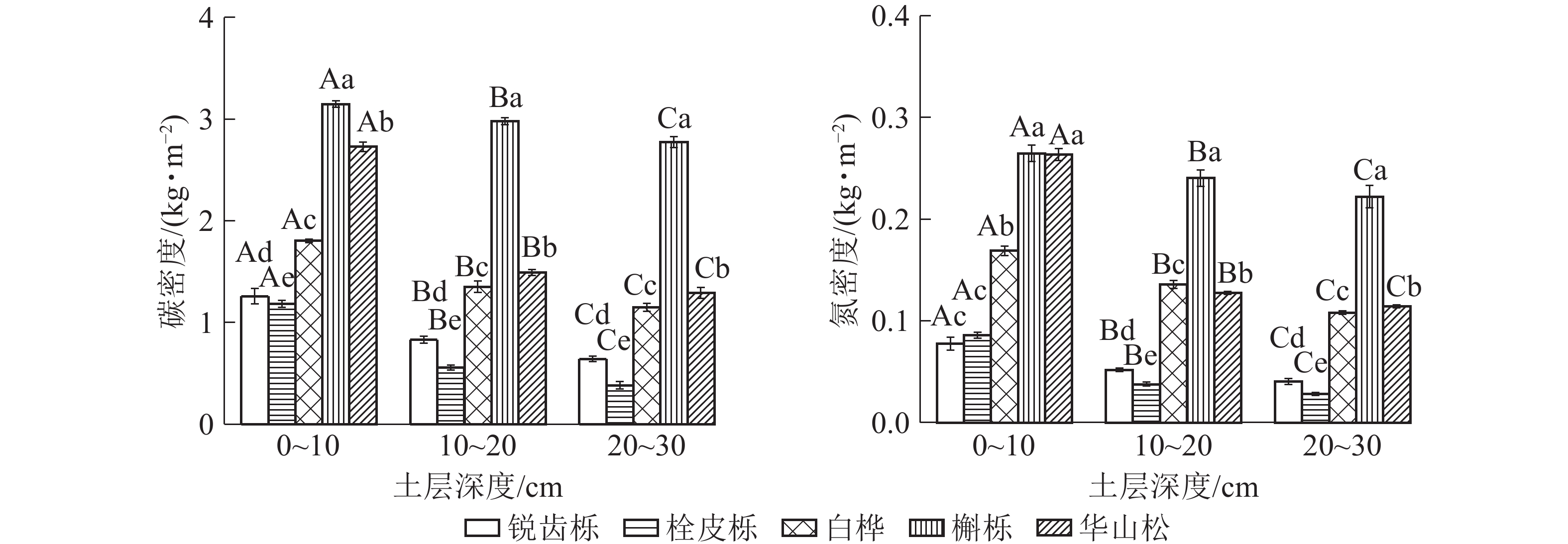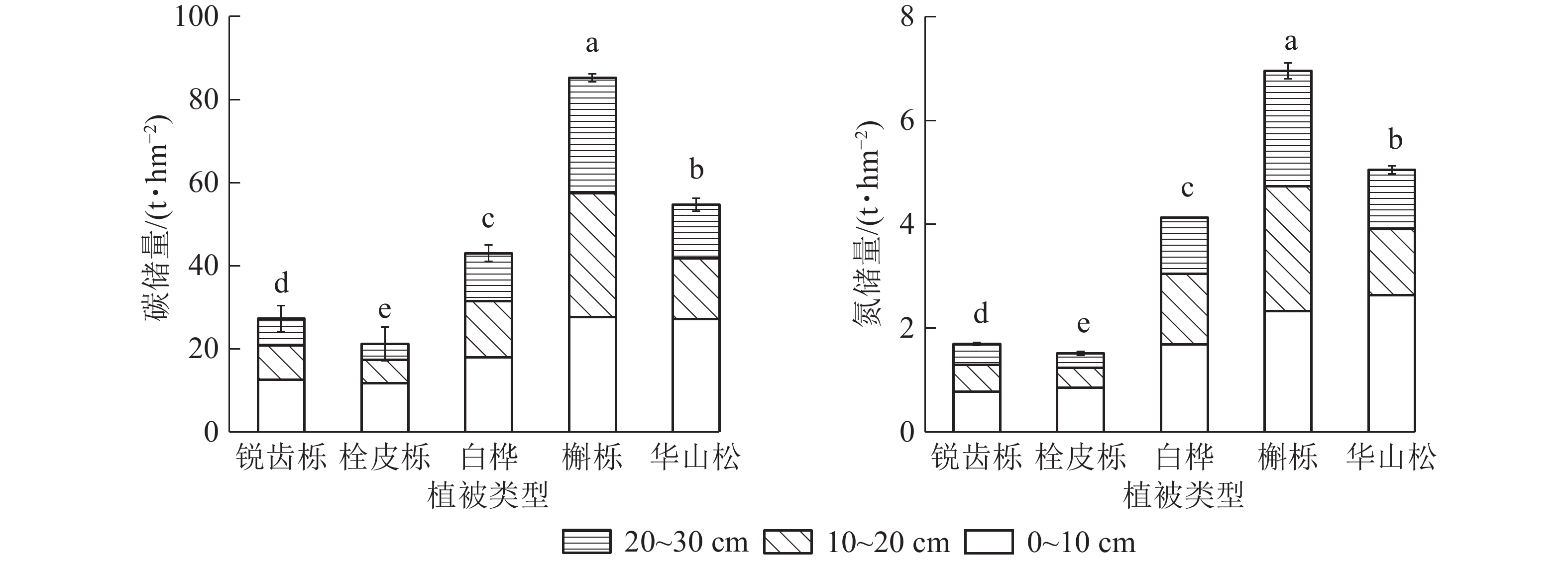-
森林生态系统是陆地生态系统的主体,占陆地总碳库的46%[1],而森林土壤碳库是森林生态系统碳库的主体,其土壤中的有机碳储量占全球土壤有机碳储量的73%[2]。全球土壤有机碳库的微小变化能引起大气中二氧化碳的显著波动,进而对全球的气候产生影响[3-4]。森林土壤中的氮素超过森林生态系统总氮量的85%[5],在物质循环中起着非常重要的作用,且土壤氮素与土壤有机碳关系密切。有研究认为:土壤氮库可以作为表征土壤固碳潜力的指标之一[6-7]。土壤有机碳和氮素是土壤养分的重要组成部分,也是生态系统中极其重要的生态因子,其含量的多少会对生态系统的稳定性乃至全球生态系统的碳氮循环产生影响[8-9]。近年来,土壤碳氮库的研究多集中在全球或区域大尺度。土壤碳氮含量受多种因素影响,如林型[10]、大气沉降[11]、经营措施[12]等。这些导致大尺度森林土壤有机碳储量估算依旧存在很大的不确定性,因此研究小尺度上有机碳氮含量及储量就显得较为重要。李海滨等[13]研究了莲花山白盆珠自然保护区植被类型对碳氮含量的影响,任玉连等[14]研究南滚河自然保护区不同森林类型碳储量随海拔梯度的变化规律,ZHAO等[15]研究不同生态系统类型有机碳和总氮储量的差异性。这些研究表明:不同植被类型能引起土壤理化性质和林内微气候的变化,进而对各自区域内土壤碳氮分布及储量产生重要影响。同时,自然保护区作为人为干扰较少、可客观了解土壤碳氮分布的自然实验室,对于揭示森林土壤碳氮循环规律,预测全球气候未来的变化趋势具有重要意义。陕西紫柏山国家级自然保护区是秦岭西部的代表地段,地形复杂,植被类型复杂多样,形成了典型而复杂的自然生态系统,对保护整个秦岭西段的生物多样性具有不可替代的作用。目前,关于该保护区的研究主要集中在植物资源调查与群落结构分析等方面,而保护区内土壤碳氮分布特征的研究比较缺乏。因此,本研究以紫柏山国家级自然保护区海拔1 400~1 550 m的5种植被类型(锐齿栎Quercus aliena var. acuteserrata林、栓皮栎Q. variabilis林、白桦Betula platyphylla林、槲栎Q. aliena林、华山松Pinus armandii林)为研究对象,分析不同植被类型下土壤有机碳和全氮的分布特征,探讨土壤碳氮的关系及其影响因素,以期揭示保护区内土壤碳氮分布规律,为保护区内森林生态系统的保护与管理提供基础资料。
HTML
-
紫柏山国家级自然保护区位于陕西省宝鸡市凤县(33°41′~33°43′N, 106°31′~106°48′E)。该保护区总面积17 472 hm2,属于暖温带半湿润山地气候区,年平均气温12.1 ℃,年平均降水量578.8 mm,主要保护对象是林麝Moschus berezovskii及其栖息地,是集生物与环境资源保护、科学研究、生态旅游于一体的综合性自然保护区。区内植被类型复杂多样,垂直变化明显,海拔1 120~2 000 m为针阔叶混交林带,以锐齿栎、栓皮栎、槲栎、油松P. tabuliformis、华山松、山杨Populus davidiana、白桦、椴树Tilia tuan等为主要树种,海拔1 800~2 200 m为桦木林带,以红桦B. albo-sinensis、牛皮桦B. albo-sinensis var. septentrionalis为主要树种,海拔2 200 m以上为亚高山冷杉Abies fargesii、云杉Picea asperata林。区内土壤以棕壤、暗棕壤和山地草甸土为主,海拔1 400 m以下以棕壤为主,1 400~2 300 m以棕色森林土为主,2 300 m以上为山地草甸土[16]。
-
以紫柏山国家级自然保护区内海拔、坡向、林龄等初始条件基本一致的锐齿栎林、栓皮栎林、白桦林、槲栎林和华山松林5种植被类型下土壤为研究对象,其中锐齿栎林、栓皮栎林和白桦林位于砂质土区域,槲栎林和华山松林位于壤土区域,于2019年8月在5个植被类型内分别设置3个20 m×20 m的样地。样地基本概况详见表1。
植被类型 北纬(N) 东经(E) 土壤类型 海拔/m 坡位 坡向 林龄/a 锐齿栎林 33°42′37′′ 106°47′28′′ 砂质土 1 406 中 东南 25 栓皮栎林 33°42′44′′ 106°47′17′′ 砂质土 1 420 中 东南 20 白桦林 33°42′59′′ 106°46′12′′ 砂质土 1 450 中 东南 20 槲栎林 33°43′06′′ 106°46′50′′ 壤土 1 424 中 南 25 华山松林 33°41′38′′ 106°48′08′′ 壤土 1 546 中 南 26 Table 1. Basic situation of the sample plots
-
在每个20 m×20 m样地内沿对角线确定3个剖面取样点,去除表面枯枝落叶层,挖取30 cm深的土壤剖面,使用100 cm3环刀在0~10、10~20、20~30 cm 3个土层采集未搅动的自然状态原状土,称量后带回实验室。同时,在每个20 m×20 m样地内沿“S”型路线确定5个土钻样点,利用直径5 cm的土钻按照0~10、10~20、20~30 cm 3个土层取样,同一土层的5份钻土混合均匀后合并成1个土样,去除植物根系等杂物,过2 mm筛,在室温下风干备用。
土壤有机碳采用外加热重铬酸钾容量法测定,全氮采用凯氏定氮法测定,容重和孔隙度(总孔隙度、毛管孔隙度、非毛管孔隙度)采用环刀法定,土壤含水率采用烘干法测定,pH采用酸度计法(水土比2.5∶1.0),电导率采用DDSJ-308F模型电导率仪测定(水土比2.5∶1.0),具体方法参考《土壤农化分析》[17]。
-
土壤有机碳密度是指单位面积一定深度的土层中土壤有机碳的储量,是衡量有机碳储量的重要指标。计算方法[18]:
$ {d_{\rm{C}}} = {M_{{\rm{SOC}}}} \times {B_{\rm{D}}} \times H \times \left( {1 - {G_i}} \right)/100$ 。其中:dC表示土壤有机碳密度(kg·m−2),MSOC表示土壤有机碳质量分数(g·kg−1),BD表示土壤容重(g·cm−3),H表示土层厚度(cm),Gi表示粒径>2 mm的石砾所占体积百分比(%)。因研究区所取剖面土样中无粒径>2 mm的石砾,所以Gi=0。单位面积一定深度内土壤有机碳储量计算方法[18]:
$s_{\rm{C}} = \displaystyle\sum _{i = 1}^n{M_{{\rm{SOC}}i}} \times {B_{{\rm{D}}i}} \times {H_i} \times \left( {1 - {G_i}} \right)/100$ 。其中:sC表示土壤有机碳储量(t·hm−2),n=3,表示土层数。土壤氮密度(dN)和储量(sN)采取同样的计算方法。土壤碳氮比是指土壤有机质中的有机碳总量和全氮之比,计算方法:RC∶N=MSOC/MTN。其中:RC∶N为碳氮比,MSOC为土壤有机碳质量分数,MTN为全氮质量分数。
对不同植被类型、不同土层土壤碳氮指标进行单因素方差分析(Duncan),利用Pearson双变量相关分析土壤碳氮比及土壤理化性质之间的关系,采用一元线性回归分析土壤有机碳和全氮质量分数之间关系。数据分析均用SPSS 18.0软件进行,利用CANOCO 5.0软件对研究区土壤碳氮质量分数及碳氮比与土壤理化性质的关系进行冗余分析。利用Origin 2017软件绘图,图中数据均为平均值±标准差。
1.1. 研究区概况
1.2. 样地设置
1.3. 土壤样品采集与分析
1.4. 数据处理
-
不同植被类型土壤有机碳和全氮质量分数随着土层深度的增加逐渐减小,各植被类型0~10 cm土层处土壤有机碳和全氮质量分数显著高于其他2个土层(P<0.05)(图1),表明土壤有机碳和全氮质量分数的分布具有较强的表聚性。不同植被类型间土壤有机碳和全氮质量分数总体表现为壤土区显著高于砂质土区(P<0.05),壤土区内的土壤有机碳质量分数在各个土层均表现为槲栎林显著高于华山松林(P<0.05),全氮质量分数在0~10 cm处表现为华山松林显著高于槲栎林(P<0.05)。在10~20和20~30 cm处全氮分布特征与土壤有机质相同,槲栎林全氮质量分数比华山松分别高0.62、0.63 g·kg−1,砂质土区内土壤有机质和全氮在各个土层均表现为白桦林显著高于锐齿栎林和栓皮栎林(P<0.05)。
-
由图2可以看出:不同植被类型下碳密度和氮密度在0~30 cm土壤剖面内由上而下均呈现下降的趋势,体现出较强的表聚性,且在同一土层处具有显著差异(P<0.05)。不同植被类型间碳密度总体表现为壤土区内植被类型(槲栎林、华山松林)显著高于砂质土区内植被类型(锐齿栎林、栓皮栎林、白桦林)(P<0.05),其中壤土区内碳密度表现为槲栎林显著高于华山松林(P<0.05),0~10、10~20和20~30 cm土层分别高0.42、1.48、1.49 kg·m−2,砂质土区内碳密度从大到小依次表现为白桦林、锐齿栎林、栓皮栎林,且各个土层均以白桦林最高,其显著高于锐齿栎林和栓皮栎林(P<0.05)。不同植被类型间氮密度总体表现为壤土区内植被类型显著高于砂质土区内植被类型(P<0.05),壤土区内氮密度表现为槲栎林大于华山林,砂质土区内氮密度从大到小依次表现为白桦林、锐齿栎林、栓皮栎林,与碳密度分布特征相似。

Figure 2. Distribution characteristics of density of soil organic carbon and total nitrogen under different vegetation types
由图3可见:5种植被类型碳储量和氮储量总体表现为壤土区内植被类型显著高于砂质土区内植被类型(P<0.05)。槲栎林在0~30 cm土层碳储量和氮储量累积达85.22和6.96 t·hm−2,显著高于华山松林(P<0.05)。白桦林碳储量和氮储量累积达43.06和4.13 t·hm−2,分别是锐齿栎林和栓皮栎林的1.56、4.02倍和2.43、2.72倍。从碳储量和氮储量分布来看,5种植被类型在0~10 cm土层处碳储量和氮储量分别占0~30 cm土层处碳储量和氮储量的33%~57%,表明表层碳储量和氮储量的贡献率最大。
-
土壤碳氮比是评价土壤质量的重要指标。锐齿栎林的碳氮比随着土层深度的增加而逐渐减小,其他植被类型未表现出明显的规律。在0~10和10~20 cm土层,各植被类型土壤碳氮比差异显著(P<0.05),且均以白桦林的碳氮比最小,分别为10.67和9.94(表2)。在20~30 cm土层,锐齿栎林的碳氮比与其他植被类型碳氮比存在显著差异(P<0.05),但其他4种植被类型的碳氮比无显著差异(P>0.05),且所有植被类型在不同土层处均表现为无显著差异(P>0.05)。各植被类型土壤碳氮比平均值从大到小依次为锐齿栎林(16.08)、栓皮栎林(14.00)、槲栎林(12.26)、华山松林(11.12)、白桦林(10.42)。
土层/cm 不同植被类型下土壤碳氮比 锐齿栎林 栓皮栎林 白桦林 槲栎林 华山松林 0~10 16.23±1.29 Aa 13.77±0.41 Ab 10.67±0.21 Ad 11.90±0.39 Ac 10.35±0.06 Ad 10~20 16.02±0.53 Aa 14.69±0.20 Ab 9.94±0.22 Ad 12.38±0.16 Ac 11.70±0.56 Ac 20~30 15.98±1.46 Aa 13.54±0.69 Ab 10.63±0.23 Ad 12.49±0.56 Abc 11.29±0.09 Acd 平均值 16.08 14.00 10.42 12.26 11.12 说明:不同大写字母表示同一植被类型不同土层间差异显著(P<0.05),不同小写字母表示同一土层类型不同植被间差异显著(P< 0.05) Table 2. Distribution characteristics of soil C∶N under different vegetation types
不同植被类型下土壤有机碳和全氮表现出极显著的线性关系(P<0.01)。在壤土区,华山松林土壤全氮对总有机碳的决定系数(R2)高于槲栎林(表3),说明与槲栎林相比,华山松林土壤有机碳的积累在更大程度上依赖氮积累;在砂质土区,决定系数(R2)从大到小依次为白桦林、锐齿栎林、栓皮栎林,说明白桦林碳氮协同积累特征更明显。这一现象与华山松林土壤碳氮比低于槲栎林,白桦林土壤碳氮比低于锐齿栎林和栓皮栎林一致。此外,壤土区土壤全氮对总有机碳的决定系数(R2)高于砂质土区,其线性回归曲线斜率也高于砂质土区(表4),反映壤土区中氮的积累更有利于促进碳的积累。
植被类型 样点数 回归方程 R2 显著性 锐齿栎林 9 y=15.780x+0.122 0.956 <0.01 栓皮栎林 9 y=13.644x+0.127 0.922 <0.01 白桦林 9 y=10.743x−0.313 0.984 <0.01 槲栎林 9 y=6.716x+8.191 0.705 <0.01 华山松林 9 y=9.435x+1.660 0.995 <0.01 全部 54 y=10.393x+1.429 0.949 <0.01 说明:x为全氮质量分数,y为有机碳质量分数 Table 3. Relationship between SOC and TN under different vegetation types
土壤类型 样点数 回归方程 R2 显著性 砂质土 27 y=9.113x+2.041 0.887 <0.01 壤土 18 y=10.864x+1.037 0.919 <0.01 说明:x为全氮质量分数,y为有机碳质量分数 Table 4. Relationship between SOC and TN under different soil types
-
Pearson相关分析表明(表5):土壤有机碳和全氮呈极显著正相关(P<0.01),土壤有机碳、全氮与土壤容重呈显著正相关(P<0.05),与土壤含水率呈极显著正相关(P<0.01),但与土壤pH、土壤电导率、总孔隙度、毛管孔隙度、非毛管孔隙度的相关性不显著;土壤碳氮比与土壤容重、土壤含水率和pH均呈极显著负相关(P<0.01),与土壤毛管孔隙度呈显著正相关(P<0.05),与土壤电导率、总孔隙度无显著相关。
项目 土壤有机碳 全氮 土壤容重 土壤含水量 pH 土壤电导率 总孔隙度 毛管孔隙度 非毛管孔隙度 土壤有机碳 1 0.974** 0.311* 0.729** 0.008 0.032 0.221 0.250 0.051 全氮 1 0.336* 0.733** 0.166 0.028 0.195 0.189 0.082 碳氮比 −0.501** −0.478** −0.645** 0.106 0.284 0.309* 0.078 说明:**表示极显著相关(P<0.01),*表示显著相关(P<0.05) Table 5. Correlation coefficients of soil organic carbon, total nitrogen, C∶N and influencing factors
对土壤理化性质(环境变量)与土壤有机碳、全氮和碳氮比(响应变量)进行冗余分析(RDA),得到了环境变量对土壤有机碳、全氮和碳氮比影响的二维排序图(图4)。由环境轴的长度及其与响应变量的夹角可知:土壤含水率、pH和土壤容重对土壤有机碳、全氮和碳氮比影响较大,其中土壤含水率是主要影响因子。土壤有机碳、全氮和碳氮比在第1轴、第2轴的解释量分别为65.84%和5.83%,累计解释量为71.67%。由此可见:前第1轴和第2轴能够很好地反映土壤有机碳、全氮和碳氮比与土壤理化性质的关系,且主要由第1轴决定。
2.1. 土壤有机碳和全氮质量分数的分布特征
2.2. 土壤有机碳和全氮密度与储量分布特征
2.3. 土壤碳氮关系特征
2.4. 土壤有机碳、全氮及碳氮比的影响因素
-
紫柏山国家级自然保护区壤土区各土层平均土壤有机质和全氮质量分数为12.37~18.16和1.14~1.48 g·kg−1,砂质土区平均土壤有机质和全氮质量分数为5.17~10.22和0.37~0.98 g·kg−1,表现为壤土区土壤有机质和全氮质量分数显著高于砂质土区。这是由于砂质土砂粒多,保水性能和保肥能力差,相反壤土黏粒、粉粒、砂粒比例适中,同时土壤孔隙能附着大量水分,储蓄营养。有研究证明:土壤黏粒和粉粒对土壤有机质和全氮起保护作用[19-20],且土壤含水率显著影响土壤有机质质量分数[21],因此,壤土中的有机质和全氮更容易积累。本研究表明:在壤土区内,槲栎林土壤有机质和全氮质量分数显著高于华山松林,在砂质土区内土壤有机质和全氮质量分数从大到小依次为白桦林、锐齿栎林、栓皮栎林。这是因为槲栎林凋落物厚度(2.9~3.3 cm)高于华山松林(1.5~1.7 cm),白桦林的凋落物厚度(2.1~2.3 cm)>锐齿栎林凋落物厚度(1.8~2.1 cm)>栓皮栎林凋落物厚度(1.6~1.9 cm)。不同的植被类型由于林木种类、林分郁闭度等不同而引起凋落物的厚度、组成成分及分解速率不同,进而导致土壤有机质和全氮质量分数积累不同[22]。
研究区内同一植被类型土壤有机质和全氮质量分数均随土层深度的增加而降低,存在明显的表聚现象。这与同类研究结果相同[23-24],原因可能是不同土层的土壤有机质和全氮来源存在差异,植物枯枝落叶多聚集在地表,经过微生物的作用后形成腐殖质进入土壤表层,土层越往下凋落物分解产物越少,同时树种根系在土壤剖面中的分布特征也会显著影响土壤有机碳、氮的积累。根系的吸收利用再加上土壤动物、微生物的影响,都导致了土壤有机质和全氮质量分数随土层深度增加不断降低的分布格局[25]。
土壤碳氮密度和储量由土壤容重和土壤有机质、全氮质量分数共同决定。受地下根系分布等的影响,不同植被类型下土壤容重存在差异。壤土区平均土壤容重槲栎林(1.63 g·cm−3)>华山松林(1.49 g·cm−3),砂质土区3种植被类型容重均值从大到小依次为白桦林(1.46 g·cm−3)、栓皮栎林(1.37 g·cm−3)、锐齿栎林(1.31 g·cm−3),因此,较大的容重再加上较高的土壤有机质和全氮质量分数,导致壤土区槲栎林土壤碳氮密度和储量显著高于华山松林,砂质土区白桦林土壤碳氮密度和储量显著高于栓皮栎和锐齿栎林。再者,土壤有机质、全氮质量分数存在表聚性,土层越往下养分释放量越小,所以土壤碳氮密度和储量与土壤有机质、全氮质量分数变化的规律性基本一致,随土层深度的增加而减小[26]。
-
研究区内5种植被类型土壤有机碳和全氮质量分数在各土层处存在极显著正相关关系,但土壤碳氮比差异不显著,这与同类型的研究结果相似[27-28]。因为在凋落物分解过程中,微生物利用氮时需要先破坏有机物的碳骨架,使凋落物分解时同步释放碳、氮[29],两者相互促进, 相互制约,形成协同积累[30]。本研究对不同植被类型、土壤类型以及样地整体的土壤有机质和全氮质量分数进行线性回归分析,更进一步解释了土壤有机碳和全氮分布规律的一致性。中国土壤碳氮比均值为10.0~12.0[31],全球土壤碳氮比均值为9.9~29.9[32]。本研究保护区内土壤碳氮比均值为12.78,高于中国土壤碳氮比均值,但处于全球土壤碳氮比均值的较低水平。
土壤碳氮比通过影响微生物的群落结构及代谢活动,进而影响土壤有机质的矿化作用。一般认为:微生物正常生命活动所需土壤最佳碳氮比约25∶1,碳氮比<25∶1时,有机质较容易被微生物利用,不利于土壤有机质的积累,碳氮比>25∶1时,微生物分解较困难,有机质难转化,有利于土壤有机质的积累[33]。本研究区5种植被类型0~30 cm土壤的碳氮比为9.94~16.23,均小于25,说明该区域微生物活动较为活跃,有机质分解较快,土壤有机质和全氮不易积累,因此其土壤有机质和全氮质量分数与秦岭其他林区相比较低[9, 21]。
-
相关分析和冗余分析结果均表明:土壤含水率、土壤容重是土壤有机碳、全氮和碳氮比的重要影响因子,这与前人的研究结果一致[34]。土壤水分不仅对元素运移及循环具有重要作用,它的状态还会影响微生物活性以及酶分泌的数量和活性,进而改变土壤有机质的矿化速率,且土壤含水率过低或过高都会抑制土壤酶活性。汤洁等[35]研究表明:土壤含水率对土壤有机碳有直接影响。当土壤含水率较高时,土壤团聚体的稳定性则较低,有利于有机质的分解,但达到最适宜的水分条件后,有机质的分解速率又会随着土壤含水率的增加而减少,所以土壤含水率是影响土壤碳氮的主要土壤属性因子。土壤容重影响着植物根系生长和凋落物分解,进而影响元素在土壤中的运移和积累,土壤容重小则土壤疏松,有利于碳氮在土壤中累积,容重大时则相反。此外,研究结果还表明:土壤碳氮比与pH呈极显著负相关关系,这是因为pH可以影响微生物的活性,从而影响有机质的分解[36]。















 DownLoad:
DownLoad:


